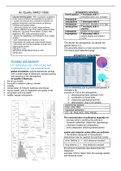College aantekeningen
MAQ11306: Air Quality summary lectures
- Instelling
- Wageningen University (WUR)
GLOBAL AIR QUALITY L01: INTRODUCTION, STRUCTURE AND COMPOSITION OF THE ATMOSPHERE L02: AIR QUALITY AND METEOROLOGY I: GLOBAL CIRCULATION L03: TROPOSPHERIC CHEMISTRY L04: STRATOSPHERIC OZONE L05: THE GREENHOUSE EFFECT REGIONAL AIR QUALITY L06: AQ AND METEOROLOGY II: BOUNDARY LAYER METEOROLO...
[Meer zien]




